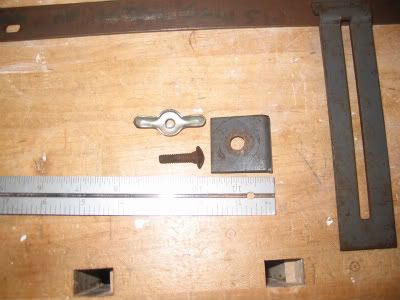
The dimensions are going to be for straight saws. Foley also made a 'crowned' carrier bar, but that'd be a bit difficult to replicate.
The horizontal bar is 44" long. The critical dimensions are the thickness (1/8") and the width (1"). The last 1" of the ends are cut at an angle for easy insertion into the machine.Pairs of holes are drilled & tapped for the vertical bars at 13.75", 18", 22", and 30.25" from the left side (nominally). The pairs are 1" on center, with the center of the pair at the distances given. For example, the second set of holes is drilled & tapped at 17.5" and 18.5" (not 18").
The vertical bars are also 1/8" thick. They are 1.5" wide and 6.75" long with a 5/16" channel cut through the middle.

In between the vertical and horizontal bar are a pair of spacers that the machine screws go through. The OD is 0.435" and the ID is 0.20", but those aren't critical. The important dimension for the spacers is the length, which is 0.55".
The screws are flathead and use a 1/8" hex head wrench and are countersunk into the vertical bars. The threads are 1/4 - 28 (or finer). The total length of the screw from top to tip is 0.795". That might be a 3/4" screw or a cut-down 1" screw.
For attaching the saw to the carrier, I like the older versions which just use a wing nut. The newer carriers use a cam lock, which is a real PITA in practice.
Below are a couple of pics for the backsaw holder. Saws without a back will use piece that looks almost identical, except that it has a bend on both sides, not just one (i.e., channel iron, not angle iron). Each piece is 1.5" x 1.5" and 1/8" thick. The bend will make it stand up about 1/4"


Feel free to post questions or comments or even links to this page. I'll try to keep it updated with the latest news on these antiquated machines!